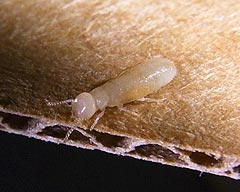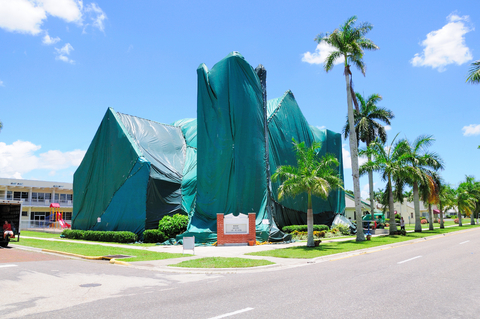Termite fumigation treatment is a long used treatment method for the control and elimination of termites, specifically drywood termites. While it is always recommended that adequate controls be in place to prevent infestations, sometimes it is not always avoidable, and more drastic methods are needed. That being said, it does pose certain risks, and should only be carried out by a trained, licensed, exterminator. This is most definitely not a DIY procedure.
If you find yourself in the situation of needing fast termite elimination, fumigation is your best option. Sometimes called tenting, due to the large tents used in the process, fumigating essentially administers a pest killing gas directly into the home in order to kill and/or repel a large number of termites at one time.
The process of termite fumigation or tenting
Termite fumigation requires a fair amount of prep work to be completed in advance in order to assure your safety, as well as the safety of your family and pets. The first thing that needs to be done is that all living beings, including people, plants, and pets, must be taken out of the home. All food, medicine, and soft furniture items such as pillows, mattresses, and box springs should be placed in a “fume bag”, which will be provided by the exterminator.
 From here, the plants close to the exterior of the home should be pruned back to allow the exterminator clear access to the perimeter. This area should also be watered to prevent the fumigant from penetrating into the soil, as this could kill the plantings. Finally, all external items attached to the home should be removed, such as satellite dishes, antennae, some types of fencing, and weather vanes. This needs to be done so the tent can fully cover the home.
From here, the plants close to the exterior of the home should be pruned back to allow the exterminator clear access to the perimeter. This area should also be watered to prevent the fumigant from penetrating into the soil, as this could kill the plantings. Finally, all external items attached to the home should be removed, such as satellite dishes, antennae, some types of fencing, and weather vanes. This needs to be done so the tent can fully cover the home.
Once this prep work has been completed, the fumigation process will begin. This process typically lasts anywhere from 24 to 48 hours, and involves pumping one of two types of gas into the home: methyl bromide, which is not widely used any longer, and Vikane gas, which is more popular today. This gas is odorless, colorless, and will not leave behind any type of reside in the home. Chloropicrin, a type of tear gas, is often added to the fumigation process as a means of preventing people from entering during fumigation.

Above – A building undergoing termite fumigation (or tenting).
When the fumigation has been completed, the exterminator will return to the home and aerate the premises for an additional 6 to 8 hours. Once the entire process is done, the exterminator will certify that the home is safe for re-entry. It is important to note that some side effects may still be experienced following certification. Common symptoms include: tearing, coughing, headaches, and nausea. If any of these symptoms are noted, residents should leave the home and contact the exterminator promptly.
Fumigating quickly knocks down a variety of termite species such as subterranean, drywood, and any flying termites, but it is really only a last resort option for serious infestations of drywood termites. Subterranean termites may be chased off for a while, but since their nests are below ground, their colonies won’t be affected – and they will come back.
For homes plagued with multiple drywood termite infestations though, this is a fast and effective way to eliminate the termites – but beware the risks. The gases used for fumigation are poisonous and a good amount of prep work must be done, before and after. Currently, termite fumigation treatment is still regarded as one of the main methods used to eliminate extensive drywood termite infestations in a building.
